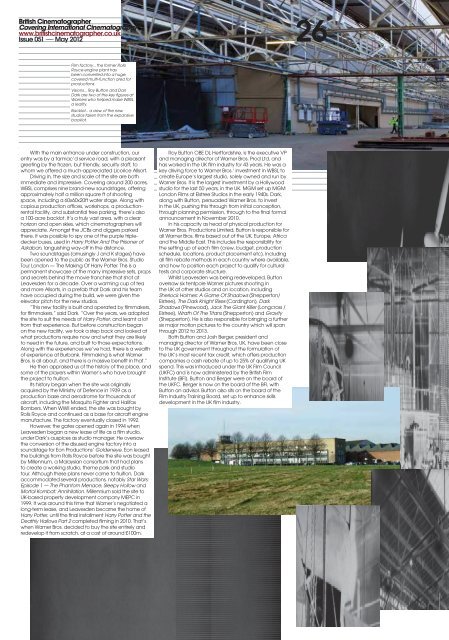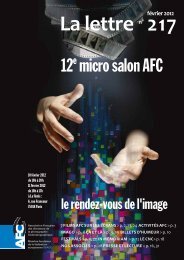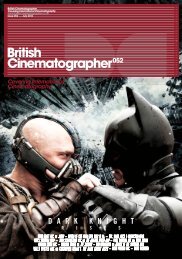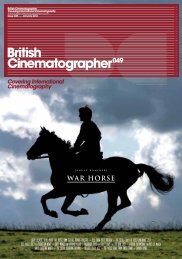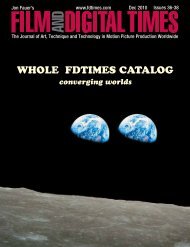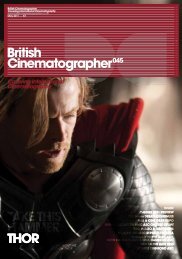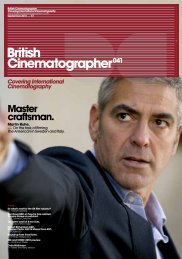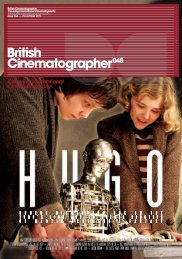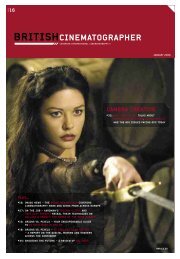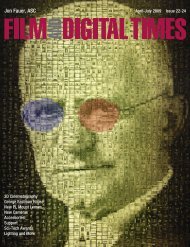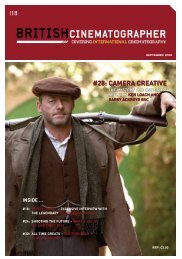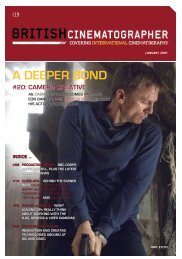British Cinematographer issue 51 - Imago
British Cinematographer issue 51 - Imago
British Cinematographer issue 51 - Imago
Create successful ePaper yourself
Turn your PDF publications into a flip-book with our unique Google optimized e-Paper software.
<strong>British</strong> <strong>Cinematographer</strong><br />
Covering International Cinematography<br />
www.britishcinematographer.co.uk<br />
Issue 0<strong>51</strong> ––– May 2012 26<br />
Film factory... the former Rolls<br />
Royce engine plant has<br />
been converted into a huge,<br />
covered multi-function area for<br />
productions.<br />
Visions... Roy Button and Dan<br />
Dark are two of the key figures at<br />
Warners who helped make WBSL<br />
a reality.<br />
Backlot... a view of the new<br />
studios taken from the expansive<br />
backlot.<br />
With the main entrance under construction, our<br />
entry was by a tarmac’d service road, with a pleasant<br />
greeting by the frozen, but friendly, security staff, to<br />
whom we offered a much-appreciated Licorice Allsort.<br />
Driving in, the size and scale of the site are both<br />
immediate and impressive. Covering around 200 acres,<br />
WBSL comprises nine brand-new soundstages, offering<br />
approximately half a million square ft of shooting<br />
space, including a 60x60x20ft water stage. Along with<br />
copious production offices, workshops, a productionrental<br />
facility, and substantial free parking, there’s also<br />
a 100-acre backlot. It’s a truly vast area, with a clear<br />
horizon and open skies, which cinematographers will<br />
appreciate. Amongst the JCBs and diggers parked<br />
there, it was possible to spy one of the purple tripledecker<br />
buses, used in Harry Potter And The Prisoner of<br />
Azkaban, languishing way-off in the distance.<br />
Two soundstages (amusingly J and K stages) have<br />
been opened to the public as the Warner Bros. Studio<br />
Tour London — The Making Of Harry Potter. This is a<br />
permanent showcase of the many impressive sets, props<br />
and secrets behind the movie franchise that shot at<br />
Leavesden for a decade. Over a warming cup of tea<br />
and more Allsorts, in a prefab that Dark and his team<br />
have occupied during the build, we were given the<br />
elevator pitch for the new studios.<br />
“This new facility is built and operated by filmmakers,<br />
for filmmakers,” said Dark. “Over the years, we adapted<br />
the site to suit the needs of Harry Potter, and learnt a lot<br />
from that experience. But before construction began<br />
on the new facility, we took a step back and looked at<br />
what productions require now and what they are likely<br />
to need in the future, and built to those expectations.<br />
Along with the experiences we’ve had, there is a wealth<br />
of experience at Burbank. Filmmaking is what Warner<br />
Bros. is all about, and there is a massive benefit in that.”<br />
He then appraised us of the history of the place, and<br />
some of the players within Warner’s who have brought<br />
the project to fruition.<br />
Its history began when the site was originally<br />
acquired by the Ministry of Defence in 1939 as a<br />
production base and aerodrome for thousands of<br />
aircraft, including the Mosquito Fighter and Halifax<br />
Bombers. When WWII ended, the site was bought by<br />
Rolls Royce and continued as a base for aircraft engine<br />
manufacture. The factory eventually closed in 1992.<br />
However, the gates opened again in 1994 when<br />
Leavesden began a new lease of life as a film studio,<br />
under Dark’s auspices as studio manager. He oversaw<br />
the conversion of the disused engine factory into a<br />
soundstage for Eon Productions’ Goldeneye. Eon leased<br />
the buildings from Rolls Royce before the site was bought<br />
by Millennium, a Malaysian consortium that had plans<br />
to create a working studio, theme park and studio<br />
tour. Although these plans never came to fruition, Dark<br />
accommodated several productions, notably Star Wars:<br />
Episode 1 — The Phantom Menace, Sleepy Hollow and<br />
Mortal Kombat: Annihilation. Millennium sold the site to<br />
UK-based property development company MEPC in<br />
1999. It was around this time that Warner’s negotiated a<br />
long-term lease, and Leavesden became the home of<br />
Harry Potter, until the final installment Harry Potter and the<br />
Deathly Hallows Part 2 completed filming in 2010. That’s<br />
when Warner Bros. decided to buy the site entirely and<br />
redevelop it from scratch, at a cost of around £100m.<br />
Roy Button OBE DL Hertfordshire, is the executive VP<br />
and managing director of Warner Bros. Prod Ltd, and<br />
has worked in the UK film industry for 43 years. He was a<br />
key driving force to Warner Bros.’ investment in WBSL to<br />
create Europe’s largest studio, solely owned and run by<br />
Warner Bros. It is the largest investment by a Hollywood<br />
studio for the last 50 years, in the UK. MGM set up MGM<br />
London Films at Elstree Studios in the early 1940s. Dark,<br />
along with Button, persuaded Warner Bros. to invest<br />
in the UK, pushing this through from initial conception,<br />
through planning permission, through to the final formal<br />
announcement in November 2010.<br />
In his capacity as head of physical production for<br />
Warner Bros. Productions Limited, Button is responsible for<br />
all Warner Bros. films based out of the UK, Europe, Africa<br />
and the Middle East. This includes the responsibility for<br />
the setting up of each film (crew, budget, production<br />
schedule, locations, product placement etc), including<br />
all film rebate methods in each country where available,<br />
and how to position each project to qualify for cultural<br />
tests and corporate structure.<br />
Whilst Leavesden was being redeveloped, Button<br />
oversaw six tentpole Warner pictures shooting in<br />
the UK at other studios and on location, including<br />
Sherlock Holmes: A Game Of Shadows (Shepperton/<br />
Elstree), The Dark Knight Rises (Cardington), Dark<br />
Shadows (Pinewood), Jack The Giant Killer (Longcross /<br />
Elstree), Wrath Of The Titans (Shepperton) and Gravity<br />
(Shepperton). He is also responsible for bringing a further<br />
six major motion pictures to the country which will span<br />
through 2012 to 2013.<br />
Both Button and Josh Berger, president and<br />
managing director of Warner Bros. UK, have been close<br />
to the UK government throughout the formulation of<br />
the UK’s most recent tax credit, which offers production<br />
companies a cash rebate of up to 25% of qualifying UK<br />
spend. This was introduced under the UK Film Council<br />
(UKFC) and is now administered by the <strong>British</strong> Film<br />
Institute (BFI). Button and Berger were on the board of<br />
the UKFC. Berger is now on the board of the BFI, with<br />
Button an advisor. Button also sits on the board of the<br />
Film Industry Training Board, set up to enhance skills<br />
development in the UK film industry.<br />
27<br />
<strong>British</strong> <strong>Cinematographer</strong><br />
Covering International Cinematography<br />
www.britishcinematographer.co.uk<br />
Issue 0<strong>51</strong> ––– May 2012<br />
Button would not reveal details of what films might<br />
be booking at WBSL in 2012-13, but his office shelves<br />
were overflowing with scripts.<br />
Dark said: “We have been fielding offers for quite<br />
a while and have got a number of pencils,” he said.<br />
When questioned as to whether WBSL would be the<br />
private domain for Warner Bros. own productions,<br />
he commented, “Obviously, the new studios are a<br />
strategic decision as much as a financial one, but we’re<br />
open to all-comers involved in motion picture, TV and<br />
commercials production. We wouldn’t be doing this if<br />
the demand wasn’t there from the other majors as well.<br />
The studio operates as a commercial entity its own right.<br />
Whilst Warner Bros. will probably be our biggest client,<br />
they will be a client like everyone else, we’ll take great<br />
care of every production whilst they are here.”<br />
We learnt that Dark was appointed to the role of<br />
senior vice president of WBSL, in January 2011, a role<br />
that sees him overseeing the entire Warner Bros. facility<br />
at Leavesden. Moviemaking runs through Dark’s veins<br />
as his father, John Dark, was a well-known film producer<br />
(What’s New Pussycat, Casino Royale, Shirley Valentine),<br />
and from an early age he worked on the set of his father’s<br />
films during the school holidays. He started his career<br />
as production assistant on Peter Hyams’ film Outland,<br />
worked as an assistant director on numerous large film<br />
and TV productions, and then spent 10 years working<br />
in special effects. He was part of the team that won an<br />
Oscar for special effects on James Cameron’s Aliens.<br />
In 1992 he helped to develop a 30-acre site in Spain<br />
into a film studio, which stood him in good stead when<br />
he was approached by Eon Productions to redevelop<br />
the old aero engine plant at Leavesden into a studio<br />
complex for Goldeneye. Dark remained as studio<br />
manager throughout the Harry Potter productions, and<br />
has necessarily forged close relations with the local area.<br />
He is a member of the Local Enterprise Partnership, and<br />
associated with charities and development projects in<br />
the community.<br />
Donning protective headwear, and fluorescent<br />
bibs, we embarked on our tour, visiting each of the nine<br />
stages on the lot. Each stage has a separate dimmer<br />
room, to keep noise of the lighting equipment at bay,<br />
and has air-conditioned ventilation to keep sets at the<br />
right temperature during all seasons.<br />
“We have four of the largest soundproofed stages in<br />
Europe, because we know big shows need big spaces,”<br />
remarked Dark. The voluminous E, F, G stages and C<br />
stage (offering a 45ft ceiling height, another feature that<br />
cinematographers and set designers will appreciate) are<br />
sited adjacent to shell of the former Rolls Royce engine<br />
factory. This space is now configured as covered, multifunction<br />
area for costume, props, camera, grip and<br />
support services. Fully-furnished, en-suite dressing, hair<br />
and make-up rooms, and kitchen/commissary capable<br />
of feeding 1,200 per hour, are located within the central<br />
complex. The design is such that there’s easy, covered<br />
and secure access to the sets for production talent.<br />
Workshops and the mill sit just beyond the main<br />
complex, increasing the ability to provide services such as<br />
visual effects, prosthetics, animatronics and film editing.<br />
A large concrete apron of outdoor space expands the<br />
external filming and production areas. WBSL is offering a<br />
rental facility for lighting and a range of grip equipment,<br />
run by Jackie Rowden, who is well-known amongst<br />
cinematographers and their crews having previously<br />
worked at LEE Lighting and Panalux. There are several<br />
warehouse units that are expected to be occupied by<br />
other camera, lighting and grip service companies, but<br />
at the time of writing none could be officially confirmed.<br />
The studio’s road infrastructure allows plenty of room for<br />
vehicles, trucks and executive vehicles.<br />
A key feature in making WBSL a filmmaker-friendly<br />
studio, are the production offices, called “production<br />
hubs”. Security has been recognised as being of<br />
paramount importance, and these office areas feature<br />
a swipe-card entry system, with CCTV surveillance. The<br />
design is to such a level that a production can hire<br />
rooms as required, with various combinations of offices,<br />
executive offices, bullpens, meeting rooms and kitchens.<br />
“With the new development, we worked really hard<br />
on security,” said Dark. “We looked at it as a completely<br />
clean canvas and asked what we needed to make<br />
the production feel really comfortable – even with small<br />
things, like the fact the offices can be broken down<br />
into hubs that are all security controlled, so you can<br />
seal off your own areas and don’t have productions<br />
intermingling with one another.”<br />
One wonders that, whilst WBSL offers so much, does<br />
it not also pose a threat to exciting studio facilities in the<br />
UK? When asked the $64k question, Dark commented,<br />
“Leavesden has been an important part of the<br />
filmmaking infrastructure for over a decade. If the UK had<br />
lost Leavesden it would have lost a third of its capacity to<br />
house major feature films. WBSL will enhance the already<br />
excellent levels of facilities in the UK, and reinforces what<br />
a great place the UK is for a film production.”<br />
Of course, modern filmmaking is rapidly turning<br />
digital and is all about immediacy. The site currently<br />
features a 50-seat preview theatre for screening film<br />
and digital dailies, plus high-speed, high-bandwidth<br />
connections to the outside world, and a Cisco<br />
TelePresence meeting room to host trans-Atlantic<br />
teleconference sessions.<br />
All-in-all WBSL is a studio to be reckoned with. The<br />
studio bosses say they’ve thought of everything, and<br />
it looks very much like they have. But the proof of the<br />
pudding is in the eating!


